
| What is Flavor and Fortune? |
| How do I subscribe? |
| How do I get past issues? |
| How do I advertise? |
| How do I contact the editor? |
Read 7002665 times
Connect me to:
| Home |
| Articles |
| Book reviews |
| Letters to the Editor |
| Newmans News and Notes |
| Recipes |
| Restaurant reviews |
| Article Index (all years, slow) |
| List of Article Years |
| Article Index (2024) |
| Article Index (last 2 years) |
| Things others say |
| Related Links |
| Log In... |
| Authors |
| Categories & Topics |
Fruits, Part IV: Peaches and Beyond
| by Jacqueline M. Newman |
Fruits, Desserts, and Other Sweet Foods
Summer Volume: 2017 Issue: 24(2) pages: 33 to 37
This series about fruits is by the editor who says the Chinese adore them big and beautiful, though not always ripe. It began in Volume 23-3 featuring apples, apricots, bananas, chayote, cherries, and coconuts. The second part was with some citrus, and dates, durian, figs, gingko, goji, gooseberries, grapes, and guava. The third part discussed hawthorn, kiwi, li zhi, longan, loquat, Chinese olives, and papaya. Each fruit includes a single recipe, and is in alphabetical order. This fourth part continues starting with with peaches.
Overall, fruits can be ripe, flavorful, and fantastic, and less ripe ones add texture, ripe or not. The Chinese often share a whole fruit with many others at the end of a main meal, particularly if an apple or a pear. They do love all their fruits big and beautiful, crisp, too.
Some fruit recipes were published before this series began, therefore, check this magazine’s index for them. Others will be discussed in future issues. If you know a popular fruit in China, do not let it be omitted, so do advise. Future issues will include berries from a single ovary, simple and small, those with pits or seeds such as the blackberry, those from flowering plants with enclosed ovules that become seeds or nuts, and fruits known as ‘modified berries’ including those with five or more carpels, with flesh under or on top of their skins, and others.
Are you confused about any we might be thinking of? So are many botanically-minded folk who simply group them as fruits not by their segmentation, peel, seeds, etc. They simply know they are delicious, healthy, loaded with polyphenols, flavanoids, tannins, and/or other phytochemicals, and with nutrients. This fourth part begins with peaches and continues with persimmons, pineapples, pitayas, pomegranates, tomatoes, and waters chestnuts. Yes, all of these are fruits loved by the Chinese. If ones you love are missing from this series, perhaps the Chinese love them less than you do.
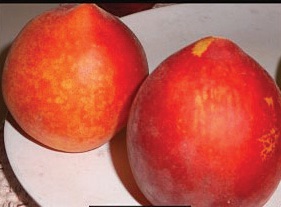
Peaches are very popular in China. In the past, most had fuzzy exteriors. Newer cultivars do not. Native to Northwest China, most still have large hard pits and flesh that can be white, yellow, or orange. Either freestone or with cling stones, they and plums and nectarines, the Chinese believe, can ward off obesity-related diseases such as diabetes or cardiovascular ones. These and many other fruits have many bio-active compounds and pigments. Some can include phenolic, anthocyaninic, chlorogenic, quercetinic, and catechinic. Some reduce LDLs, the so-called bad cholesterols, so do eat lots of them, and often.
Peaches are an excellent source of Vitamin C; they help fight the formation of free radicals that cause cancer, have lots of fiber, may reduce wrinkles, lower blood glucose and blood sugar levels, and regulate lipid and insulin levels. Their potassium supports heart heath, too. Some research says eating three or more servings every day can decrease progression of age-related macular degeneration.
| Peaches, Conpoy, and Doufu |
|---|
3 conpoy (dried scallops) soaked in warm water overnight
1. Tear the soaked conpoy into thin strips.
|
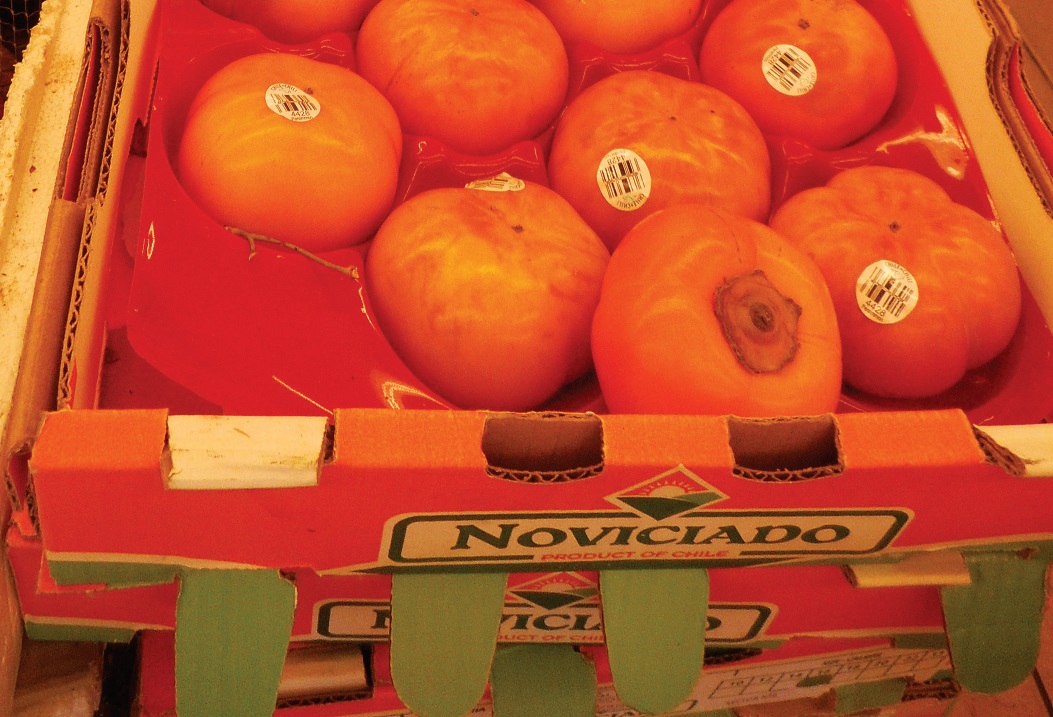
Persimmon a Diospyros fruit, is the most popular species in China where all these fruits are called shi or shi guo. Many tell us they are indigenous there. Ancient Chinese said one can eliminate their astringent tannic tastes by steaming or smoking them, and by freezing them. This taste goes away naturally when they are very ripe. Many pits were found at neolithic sites in North China, some at tombs near Changsa, others in Manchuria or Guangzhou, or near ancient trees or ancient tombs in many places.
Very few Chinese recipes for this fruit are known even today. Some of their pollen has also been found at ancient sites, and their fruits are most often eaten dried, their pits made into oils. No recipe follows as we could not find one, but if you know one, we would love to share it with our readers. So do send it to this magazine; we would also like to know where or from whom you found it.
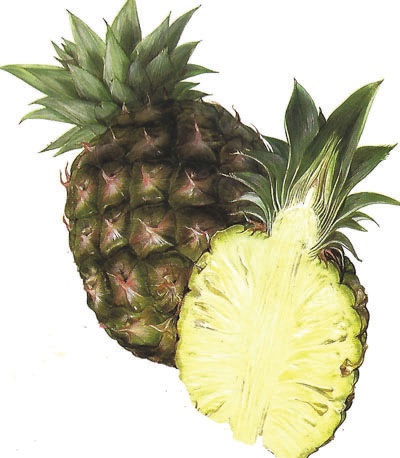
Pineapples botanically are Ananas, the Chinese call them feng li or bo luo meaning ‘phoenix pear’ or ‘earth pineapple.’ They look rough on the outside, yellow within, and when ripe are very sweet. Whole and not peeled, these fruits are covered with what some call their eyes. Each has a thorn-like hair in its center.
TCM practitioners tell us that these fruits keep the spleen healthy, relieve thirst, reduce swelling no matter where, and remove ‘wind-wetness evil.’ They also say their juice eases indigestion and vomiting, raises blood pressure if too low causing dizziness, reduces fever with weakness, improves problems with urinating, and does so much more.
| Bang Bang Pineapple Chicken |
|---|
2 chicken legs or thighs boned, their meat cut in slivers,
1. Mix cooked and drained chicken with the cucumber
slivers.
|
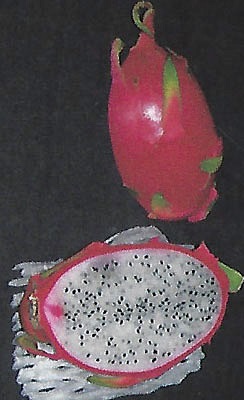
Pitaya are distinctive fruits with spikes on their outsides. Also known as dragon fruits, most have white interiors with tiny black seeds inside. Most are red outside though newer species are yellow outside and in. Years ago emperors stored these fruits in their ice houses and ate them frozen. Today, we would say that texture reminds of sherbert.
Related to cactus, these fruits are in the genus Stenocereus if sour, but the genus Hylocereus, species undatus, costaricensis or megalanthus if sweet. One unusual thing about them is that they are harvested five or six times a year, grow on trees that set their fruit thirty to fifty days after flowering. Some do grow on vines and flower and set in just a few weeks as most fruits do. All their flowers open over night, wilt by morning, and are most often pollinated by bats or moths. These fruits produce tons of fruit a year, grow best in dry tropical climates with a moderate amount of rain, and have seeds that grow well in compost and germinate quickly.
| Fermented Rice Pitaya |
|---|
3 Tablespoons pearl barley, soaked overnight, then drained
1. In a saucepan with the drained barley, add one cup
cold water and bring to the boil, then lower the eat and
simmer until tender.
|
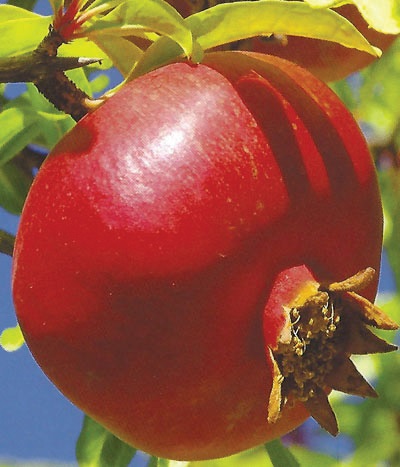
Pomegranate, the Chinese think is a seductive plant growing on shrubs or trees. They call them shi liu, an shi liu, or zhen zhu shi liu. They are thickskinned fruits with many irregular seeds. They consider them cool in nature. In English, some call them ‘stone,’ ‘pearl,’ or ‘peaceful pomegranates’ and many know they have astringent-tasting seeds said to be very healthy. The Chinese believe they cool fevers and are warm in nature. Some say their juice can kill parasites, most know they symbolize fertility and that when half open are wishes for a hundred sons. TCM practitioners frequently recommend their juice for mouth and throat irritations, hoarse throats, and persistent coughs, frequent diarrhoea, dysentery, and impetigo. What many do not know is that the skin and roots of this fruit can have some poison.
| Zhe Jiang Noodles With Pomegranate |
|---|
½ pound dry rice noodles soaked in hot water until soft, then cut into two-inch lengths
1. Mix prepared rice noodles with the chicken stock,
hoisin sauce, rice wine, and the chili sauce, and set this
aside.
|
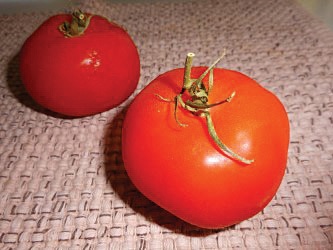
Tomato is botanically known as Lycopersicu esculentum, and most do not realize they are fruits. The Chinese call them fan qie meaning foreign eggplants or xi hong shi meaning western red persimmons. They are annual fruits and can be round, flattened, or oval. Most are green when immature. Some newer species are yellow and do not get red when ripe.
TCM doctors tell us they are neither hot nor cold, can clear a fever, cool blood, promote saliva, and help digestion. TCM folk recommend them to cure night blindness if prepared with pig liver. They say they ease loss of appetite when eaten raw, to reduce bleeding gums when dipped in sugar, reduce high blood pressure in the eye when eaten very ripe, and improve appetite loss if cooked with lean pork.
| Tomatoes With Chicken Thighs |
|---|
10 grape tomatoes, each cut in half the long way
1. Mix all the spices and then toss them with the tomato
halves.
|
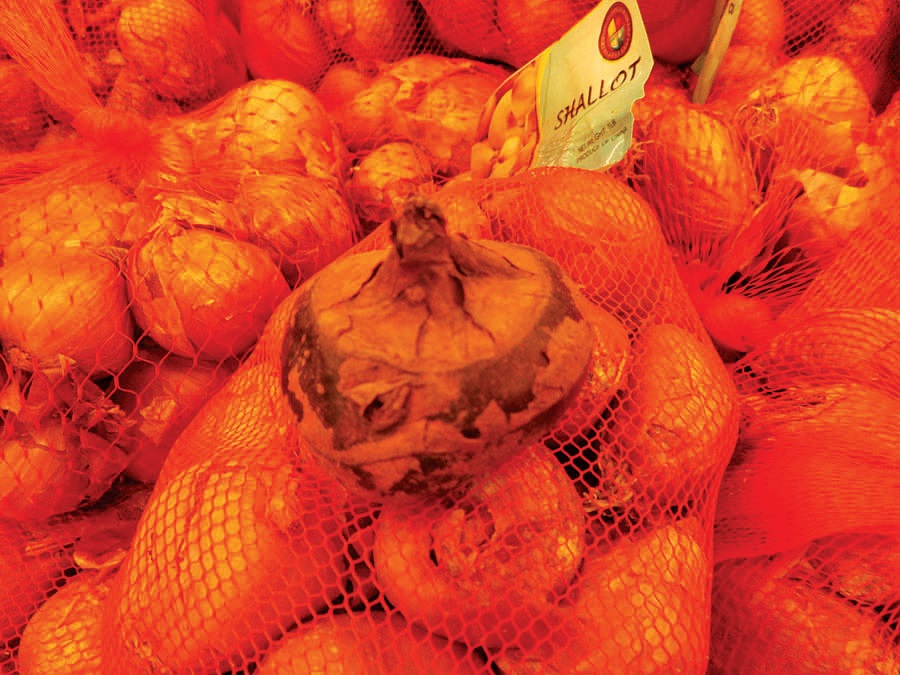
Water Chestnut, also a fruit; is botanically known as Heleocharis tuberosa. In Chinese, they call them bi qi or ma qi, the latter meaning a ‘horse hoof.’ These fruits grow in water or marshy land, their edible part is called a corm. Many people eat their leaves and stems, and love their pointed sprouts. They do not eat their peel, do love their pink or white crisp interiors. Best dug up in the fall, then their texture is very crunchy. TCM doctors tell us they are sweet in nature, can cool a fever, reduce phlegm, promote saliva, lower blood pressure, prevent meningitis, reduce sore throats; and with St. John’s wort can reduce jaundice. For those with hemorrhoids, they recommend eating them fresh without their skins. Cooked, they say they can eliminate red urine, and if cooked with cogon grass and mashed, their liquid strained, they tell us if consumed morning and night and peeled, they reduce painful throats and other mouth irritations.
| Duck With Water Chestnuts |
|---|
1 whole cooked boneless skinless duck breast
1. Mince duck breast, then toss it with minced water
chestnuts, egg whites, wine, cornstarch, and the minced
onion and ginger.
|

Copyright © 1994-2024 by ISACC, all rights reserved
Address
3 Jefferson Ferry Drive
S. Setauket NY 11720